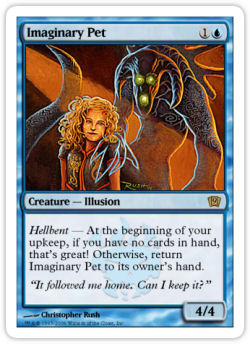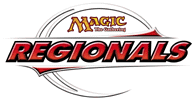Post-Dissension Regionals will be a very interesting field. For the first time in a while, the number of viable decks is staggering — just about any combination of colors can get you a good deck; aggro, control, and even combo are all viable contenders. It’s almost like the end of the pre-rotation Extended format, where the field was wide open and honestly, quite a blast.
The essential question of Regionals boils down to: “What is the expected metagame?” It’s never been hard to predict in previous years, as most Standard card sets allow for only a clear number of viable candidates. This year, however, it’s anyone’s guess as to what could show up at the top tables. The entire Ravnica block gave each two-color combination a load of goods, so it’s hard to determine a priori what the most anticipated decks will be, and how to metagames against them.
Historically, control decks have sat by the wayside in Regionals, as they are typically harder to tune and generally have reactive tendencies. Walking into a generally infirm metagames such as Regionals usually makes reactive strategies awkward, as you’re unlikely to be able to address everything that may come across your plate.
In order to get a handle on how to build a control deck, it’s important to know what you may be facing. While the anticipated list isn’t short, studying it will help us understand the commonalities between them — which will allow us to adjust our control deck appropriately. Here’s an overall review/summary of what you could theoretically expect to see in this year’s Regionals events:
Boros (R/W)
Aggro —
Pros: Efficient, evasive critters; solid burn; access to Blood Moon.
Cons: No significant card advantage mechanism.
Control —
Pros: Lots of answers, lifegain, Firemane Angel; access to Blood Moon.
Cons: Poor tempo control; very vulnerable to land destruction.
Gruul (R/G)
Pros: Cheap but massive creature fat, solid burn, access to Blood Moon.
Cons: Few “surprises”; asynchronous Savage Twister/Pyroclasm only means of card advantage.
Rakdos (R/B)
Pros: Hyper aggressive and highly disruptive — burn, discard and LD; access to Blood Moon.
Cons: Hellbent is often inconsistent; can easily “lose steam.”
Dimir (U/B)
Millstone-style Glimpse/Circu —
Pros: Completely unexpected as good builds haven’t been discovered yet.
Cons: Slow kills can give opponent time to recover.
Hunted Leyline —
Pros: Unexpected; can have explosive starts.
Cons: Vulnerable to tempo losses; can be inconsistent.
Golgari (B/G)
Pros: Lots of answers; recursive creatures, good defense; potential turn-2 Hypnotic Specter.
Cons: Aggro version generally slower than others; control version is vulnerable to mana denial.
Izzet (U/R)
Arcanizzet Combo —
Pros: Completely unexpected as a good build hasn’t been found yet.
Cons: “One-trick pony”; easy to disrupt via discard or counters.
Wildfire Control / Magnivore —
Pros: Board dominance, LD, counterspells, burn, draw power, Blood Moon.
Cons: Relies heavily on signature card.
Orzhov (B/W)
Pros: Heavy disruption; efficient threats and answers; powerful anti-strategy cards.
Cons: Well-established and understood; highly anticipated — faces uphill battle.
Simic (U/G)
Pros: Aggressive tempo deck; untargetable creatures; access to counterspells including Voidslime.
Cons: Currently unknown; potentially vulnerable to mass removal.
Azorius (U/W)
Beatdown —
Pros: Lots of evasion, efficient counters; access to Kira, Great Glass Spinner; and Hokori, Dust Drinker.
Cons: Not a whole lot of reach; stronger aggro decks are out there.
Control —
Pros: Efficient counters, lots of removal, nice draw power, good finishers.
Cons: Vulnerable to LD and discard.
Selesnya (W/G)
Greater Good / Debtor’s Knell / Yosei —
Pros: Combo lock, lots of metagame answers, draw power.
Cons: Vulnerable to mana denial and anti-control measures.
Beatdown —
Pros: Access to metagame-breakers – Loxodon Hierarch, Shining Shoal, Glare of Subdual, Hokori.
Cons: More anti-disruptive than proactive; hard to control game state
Heartbeat Combo
Pros: Wide consensus as “best deck”; combo finish with sideboarded man-plan.
Cons: Hard to play well; widely anticipated.
Enduring Ideal
Pros: Filled with answers and has a lot of anti-aggro options.
Cons: Very vulnerable to counterspells and can be wrecked by discard.
Now that we’ve reviewed the anticipated field (more or less — many of the above decks will splash for a third color), let’s extract some very basic points:
Aggro is everywhere, and has lots of tools. Almost every color combination has some form of efficient aggro, and most have access to supportive threats such as cheap burn (a la Char), hand disruption (think Cranial Extraction), counterspells (e.g. Remand), added fat (see Moldervine Cloak), and the ever-present Umezawa’s Jitte.
Cheap, tempo-oriented permission will be in any deck that can play it. Any deck that can support Remand and Spell Snare will play them, even if they are proactive aggro decks. The cards are just that good; and the easy splash makes it hard not to consider.

Expect a lot of burn. Seal of Fire, Lightning Helix, Volcanic Hammer, Shock, and Char are all going to be out in full force. There’s so much of it that a dedicated burn deck might even be possible. Efficient group burn; like Pyroclasm, Kindle the Carnage, and Savage Twister; will probably all see play as a means of clearing away threats on the board.
Lifegain is more important than it ever was in tournament Magic. The abundance of aggro, burn, and Dark Confidant has made lifegain an important aspect to staying alive long enough to execute a game plan. At the same time, the quality of life-gaining cards has increased; expect Faith’s Fetters, Loxodon Hierarch, Descendant of Kiyomaro, Azorius Herald, Overrule, etc.
Green has a potent array of mana development. Between Llanowar Elves, Elves of Deep Shadow, Birds of Paradise, Farseek, Rampant Growth, Sakura-Tribe Elder, Kodama’s Reach, and Wood Elves, Green decks can easily assemble huge quantities of mana. While I honestly wouldn’t expect to see Borborygmos, Verdant Force, or Sisters of Stone Death; cards like Protean Hulk, Simic Sky Swallower, and even Petrified Wood-Kin (as an anti-permission sideboard card) could very well see play. Even an Ursapine, long thought to be a casual card, could screw up combat and turn Elves into Baloths.
Potent hand disruption is at most decks’ disposal. Cry of Contrition may be only okay; but Delirium Skeins will outright slaughter some decks. An early Rakdos Augermage could hamper an opponent’s mana development or rip out key cards; when Fall is added on top of that, it can be downright devastating. Brain Pry and Distress are other efficient spells that could see play, too. In control mirrors, channeling a Ghost-lit Stalker could end games.
Untargetable creatures are hot. With all of the insane Ravnica-block spot removal running around, difficult-to-hit creatures will play a very important part of the threat package. The aforementioned Simic Sky Swallower and Petrified Root-Kin are on the high end; Kodama of the North Tree, Giant Solifuge, Plaxcaster Frogling, Paladin en-Vec, and maybe even Humble Budoka could be successful metagame choices. Kira, Great Glass Spinner will almost certainly find a home in some builds or sideboards.
Blood Moon will be a very important sideboard card. Since there’s no way a monocolor deck will be stronger than multicolor equivalents, most decks will be running some form of manafixing through shocklands, painlands, and bouncelands. Blood Moon could potentially manascrew an opponent into oblivion. Combined with Hokori, Wrecking Ball, Wildfire, and the normal suite of LD; manabases aren’t safe.
In a less analytical summary, that means the following:
Lots of in-yer-face fatty aggro, and…
Disruption up the wazoo.
(Hey, I gotta say this — at least if you don’t like my deck, this article was hopefully informative and prepared you for the field. A guy’s gotta do his CYA, ya know.)
Historically, dealing with this type of format usually involves some sort of White-based control, stereotypically U/W. This format is no exception — U/W control is a powerhouse, and has so many options to choose from that it’s bursting at the seams. While the format has many more answers to U/W then previous Standard cardpools had, the options are nonetheless there.
The Azorius guild is all about judgment. In this case, it serves as the Judge, Jury, and Executioner.
Creatures (6)
Lands (24)
Spells (30)

First, let’s note some important things. First off, Final Judgment is in the deck; even at six mana. The format is so aggro-centric that Wrath is not enough; especially if you get Cranialed. In addition, it helps you get around the nutty post-mortem effects of Yosei, and can take out annoying dredgers like Stinkweed Imp. It even works around Ghost Husk’s Promise of Bunrei; which is a real threat to any deck that wants to rely on Wrath to answer its problems. Six mana is a lot easier than you think — with four Chancery, it’s not hard to squeeze a lot of mileage out of the deck’s mana.
Peer through Depths plays a critical part of keeping this deck moving. With 30 maindeck instants and sorceries, PtD will almost always hit something of real value. Compulsive Research is a staple of Blue control decks in this format, so it shouldn’t surprise you to find a few in the deck. I only have three because the deck is not really so fond of tapping out on its own turn, unless it’s destroying lots of creatures.
Also note that I am not playing any of the Kamigawa legendary lands. This deck desperately needs the mana-fixing bicolor lands, so it needs high basic land counts to avoid disappointing losses to Blood Moon. Also note that I don’t run Disrupting Shoal – because, well, it sucks. In a metagame like this, where the field is way too diverse, DShoal will only be good some of the time. The only time Shoals are good is turn 4, when you Wrath and need counter backup against Remand. If you’re really sold on them, the Muddles in the board can come out for Shoals; but I don’t think it’s necessary.
Clearly, this deck will have problems in the face of heavy disruption. The turn 1 Bile Urchin, turn 2 double Cry of Contrition, sack Urchin to repeat the pain will basically end the game; but that’s not going to happen pretty often. Delirium Skeins is a must-counter proposition, though; and LD can really put you in a hole. Sacred Ground is a sideboard option; but it will eat space that you probably need allocated elsewhere. Overall, though, this deck should be okay — sideboarding against most decks running Black will involve creatures on the ground rather than spells in hand.
The basic plan is to counter most of what your opponent throws at you; with Condemn and mass removal as a backup. Anyone familiar with U/W strategies will know how to play it out; there’s nothing particularly special about it. In playtesting, I found that I forgot how much removal the deck has — let your 10 creature-kill cards deal with critters; save your counter for gut-busting spells and counter wars. Most often, the creatures you should be countering should be major threats like Northern Kodama or Giant Solifuge.
Sideboarding is fairly simple; against Red or Black aggro decks, the dorks and Threads come in as a means of mashing up the ground. Paladin en-Vec is a pain to remove in this format; Kiyomaro will help stabilize your life total (although beware of Rain of Gore) and Threads will help you two-for-one. I suggest you take out the Peers, Hinders, and Researches; since you’re clogging your three-slot otherwise. If you want, you can also consider Azorius Herald as a sideboard option; although I think it’s worse than both Paladin and Descendant for this purpose.
Against Heartbeat and other control strategies, side out two Judgements for Spell Snares and the Mana Leaks for Muddles (or Disrupting Shoals if you’re running them); which will be much more effective. Keep in mind that they could shift to the man plan; which is why your Condemns and Wraths should stay in. If you don’t anticipate seeing any Heartbeat (which is actually quite possible at Regionals due to the general aggro nature of the format), then I strongly recommend removing Muddle from your sideboard, replacing it with either Shining Shoal or Devouring Light. Reverence and Ivory Mask are also decent sideboard options.
Simic and Azorius Beatdown decks will be the most unformulated going into Regionals, seeing as how they don’t build themselves as much as Rakdos does. My recommendation is that Threads of Disloyalty will be excellent, nabbing Vinelasher Kudzus and Mistral Chargers; so they should go in along with an extra Spell Snare to take the place of PtD. If you suspect that Simic may be big in your area, and you also expect a lot of Gruul, Cytoplast Manipulator might be a sideboard answer instead; although I haven’t tested it.
Overall, the general sense is this: in control, Removal > Counters. The only reason you really need the counters is to win the counter war over the removal; since any deck running Blue will play Remand and Spell Snare. Wrath deals with almost everything; and short of a Grave-Shell Scarab with open mana, Final Judgment really is final. Condemn isn’t perfect (it won’t deal with Bob for you), but overall it’s solid.
Bonus Material: Dimir Hellbent?!? What are you spewing, Nate?

One of the most uninteresting reprints in 9th Edition was Imaginary Pet. The notion of having zero cards-in-hand wasn’t very appealing… until now. Rakdos decks could get a lot of mileage by splashing for Blue, for a number of reasons.
Besides a 4/4 guy for two mana, it adds the option of running Spell Snare – to fight off counters like Remand and Mana Leak – so that cards like Delirium Skeins can stick. You could also play the Rise half of Rise / Fall if you needed; gaining much needed card advantage in the process and/or saving yourself from a suicidal Confidant if you run it, and Mind Bend would also let you get around pesky Paladins. Who knows, maybe Time Ebb — another answer to Paladin en-Vec – could be a ridiculous tempo card in the format; as it could easily remove pesky Yoseis, Keigas, and Rumbling Slums out of the way — and reduce Vinelasher Kudzus back to 1/1s. It can even “take back” stolen creatures, if you’re willing to live with the lost draw and mana spent to recast.
Imaginary Pet is also a much safer Hellbent creature option than Jagged Poppet, who is a serious liability. It has an extra point of power, although when it connects it’s not as nasty. In any case, I think Rakdos has little to lose by splashing Blue, and the option is certainly out there.
Anyway, my time is up. Spread the love, and good look pounding the tables.
Cheers!
Nathan J
Props: The editor, “Scouseboy” — for sheer rockitude and silly English things like milk in tea. [And what, pray tell, is silly about that? — Craig.]
Slops: Azorius guild, who unlike the other guilds, didn’t get its own backbreaking bicolor uncommon.
This article brought to you by Mike Flores — because everything in Magic emanates from “Who’s the Beatdown?” And yes, that is me poking fun. Flores probably doesn’t even read my articles.

